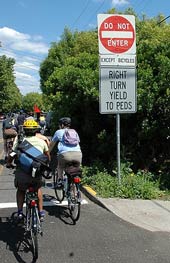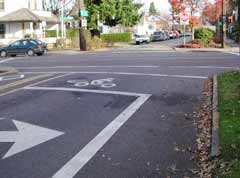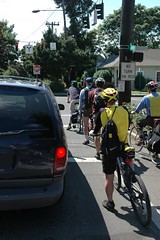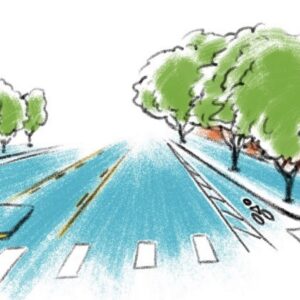[Updated: 10/9, 4:37pm]

Chapter 19.90.030 of Portland’s official City Code, defines a bicycle boulevard as “A roadway with low vehicle traffic volumes where the movement of bicycles is given priority.”
Many savvy Portland cyclists know which streets are bike boulevards, but because most of them lack design cues or visible markings, their designation is unknown to most; especially to motorists.
Now, as part of a new Bicycle Boulevard Marking Demonstration Project, PDOT plans to “combine several design elements to communicate to all road users the priority of cyclists.”
PDOT’s bike coordinator Roger Geller is working on the project with the City traffic engineer. The project was discussed at the September meeting of the Portland Bicycle Advisory Committee.
According to the official meeting minutes, three elements will be implemented as part of the project:
Big bicycle symbol. The symbol would likely be the same as the sharrow, but much bigger and placed in the center of the lane.

Step up the use of bike boxes, and improve on their design (more to international standards). There are five components to a bike box: lead in lane, advance stop line, reservoir, marking, and color. The reservoir of the bike box will be deeper, and it will be colored.

(Photo © Jonathan Maus)
Improve bicycle crossing treatments. Currently, PDOT provides a treatment when there are insufficient opportunities to cross (defined as less than one per minute). The crossing treatments would encourage the type of behavior already demonstrated voluntarily by some motorists: stopping for cyclists, even when cyclist has stop sign. Improvements would let motorists know that the intersection is a popular bike crossing.
On a recent trip to Vancouver BC, I found that the addition of bike symbols on their street signs had a huge impact on my perception of safety. I assume they were equally effective for motorists. Here are two examples:
The meeting minutes also note that, in addition to new public art being part of the effort, many committee members felt that an educational component should be done in tandem with design improvements.
The project is expected to be rolled out next spring. Stay tuned for more details.









In the spirit of \”movement of bicycles is given priority\”, PDOT needs to also consider moving stop signs off of bike routes whenever possible. Of note in SE would be the stop signs at Ladd\’s Addition, around 4th and Caruthers, and coming off of the esplanade by OBT.
\”A roadway with low vehicle traffic volumes where the movement of bicycles is given priority.\”
That reminds me of years ago when I was living (and bike commuting) in Cincinnati and the powers-that-be simply declared the city to be bike-friendly. Words. Just words.
Not that Portland is giving us lip service to that level – definitely, positively not. But I need to see more than paint on the road. HOW is the movement of bikes given priority? That\’s the issue.
One of the reasons SE Ankeny works so well are the barriers that force cars to turn off onto more arterial roads.
Those barriers are key. More than any visual cues, more than any formal designation, they make it different.
I\’d like to see the \”Boulevard definition\” include more specific physical characteristics that differentiate boulevards from more traditional streets.
I have seen another visual clue when visiting our neighbors to the north. Vancouver BC puts a bicycle symbol on their green street signs right next to the name of the street to indicate that the cross street is a bike boulevard. This discourages motorists from using the street and encourages cyclists. Those combined with the bike bike symbols let everyone know that a street is a bike boulevard which helps achieve the goal of fewer cars moving slower.
Bjorn
I agree with tonyt. I think barriers or diversions would help alot. Also I would like to see signage aimed at motorists indicating the bike blvds are for bikes and local residents ONLY, then some enforcement of said policy. In particular Clinton and Ladds where Race-Car Johnny types try to beat traffic by cutting off the streets with stoplight/signs.
I strongly support the ideas shared in the first 3 posts. I also hope they\’re looking at a bike box on SW Columbia at Naito Parkway. There are many of us PSU commuters who when trying to access the Willamette Greenway path are stuck behind rush hour traffic. Squeezing between lanes is dodgy and not appreciated by the drivers.
Bjorn said:
\”Vancouver BC puts a bicycle symbol on their green street signs right next to the name of the street to indicate that the cross street is a bike boulevard.\”
Here\’s what he\’s referring to:

and here\’s another example from BC:

Apparently, the Portland Bureau of Transportation is not allowed to do diversion anymore. Some previous commissioner didn\’t like it as a traffic calming tool.
I would love to see it reinstated again.
In the meantime, markings on the road telling drivers that bikes are given priority would be very, very welcome here in Portland.
I got into a mild altercation with an SUV driver on Clinton a few months back. When I told him Clinton was designated as a street for bikes, and not as a rat-run for cars wanting to drive eratically and at high speed, he looked around him, looked back at me, and then asked me, \”Where is the sign that tells me this?\”
To which, I could only answer, \”I don\’t know\”.
i would so LOVE some more diversions on clinton. I hate how cars think they own it sometimes during rush hour. thank goodness 39th stops their flow…
Emergency response folks don\’t like traffic diverters (as well as speed bumps) because they slow them down when they\’re in a hurry. Imagine one of those really long fire trucks trying to get around them. Official types could give more details but I do know that they are given high consideration (e.g. I think that\’s why the roundabout-type island like those on SE Clinton St. and NE 24th Ave aren\’t installed anymore).
I like speed cameras more than diversions.
A three inch high diverter like the one at SE 20th & Ankeny bike boulevard is hardly going to stop a fire truck.
Diversion is an ideal tool, when it still allows for emergency response.
At 39th, and Clinton the bike signal seems to actually attract more cars rather than discourage them. Most of them seem to be turning left, and aren\’t patient enough to give me even a foot of clearance before turning left behind me, and speeding off. Or worse hurrying to turn left before I make it into the intersection forcing me to slow down quickly to keep from getting hit.
I was mostly speaking about the roundabouts which were originally designed to slow all traffic. I think that is one reason that Clinton is a good street for biking — you can\’t barrel down it at full speed because you have to go around the circles and slow for the speed bumps. Personally, I kind of hate the roundabout circles. When I approach one on my bike and there\’s a car coming up behind me, I often get the feeling that the car may decide to try and speed up and pass me before the pinch point.
Ankeny and 20th is a much different situation — there, it\’s the less busy street that we want cars to stay off, whereas along Clinton, it\’s the street with the heavier traffic that is the bike route.
By the way, the city traffic engineer rides his bike to work.
Paul,
I don\’t think anyone was advocating roundabouts as a form of bike friendly \”diverter.\”
The 3\” bumps that Matt mentioned are really what I was talking about, and fire-trucks can handle those easily.
I think we need to find out what commissioner nixed the diverters, find who\’s in that seat now and get them back in the arsenal.
video on this very subject.
It seems that diverters are indeed important.
http://video.stumbleupon.com/#p=e45nhitb79
Traffic circles, speed bumps, & the like, are all awesome, and certainly have their place.
But.
Wehave all of those things on Clinton Street, and does it deter cars? Maybe some. But honestly, not enough. Clinton Street at rush hour is horrendous. Absolutley horrendous.
If bicycle boulevards like that are supposed to be family friendly, then that\’s just craziness. There is no way I would take a three year old with me biking on Clinton during rush hour.
The traffic circles only slow cars down for a few feet. Then they just speed up again, until the next one, where they slam on their brakes to go around it, then speed up until the next one, etc etc (you get the picture!)
The one bit about Clinton St is……. you guessed it, the intersection at 39th where, what is there in place?
A diverter that prevents motorists but allows cyclists to carry on straight!!!!
If you want to prioritize a street as a bike boulevard, it needs to have diversion to prevent car traffic. Truely. Or else you are not going to get families with their three year olds to ride on it, no matter what.
PS – Awesome video link, tony, thanks for sharing! I\’d highly recommend anyone who doesn\’t know how important diversion is as a traffic calming tool to check the video short out!
And as for who could reinstate diversion as a tool? Perhaps we could all write to Sam Adams!
I completely second Matt\’s comments about diverters. There\’s only one thing that will keep cars from clogging a road, and that\’s concrete. The diverter at Ankeny is perfectly mountable by emergency vehicles (and honestly how often does an ambulance decide to take Ankeny rather than Burnside?)
But for a good look at bicycle symbology, you should look at the bicycle symbols installed near SE 92nd Ave as part of the 205 MAX project. The symbols are as large as sharrows and very visible. (maybe Matt can snap a picture)
the whole emergency response thing is a red herring tossed out there by car lovers who abhor any restrictions on their movement
my 2 cents on clinton: i bike west on clinton at
4:30ish everyday. so i\’m going opposite everyone else, right. i\’m super tired of having to hug all the parked cars i\’m riding by because some asshole is coming at me in my lane as they\’re passing fellow bikers (heading east). i\’m on a bike so i\’m not important enough to yield to? apparently not.
Matt: If you liked that link, you can check out the whole movie that it\’s a part of here:
http://www.streetfilms.org/archives/portland-celebrating-americas-most-livable-city/
Enjoy.
Greg
now if we could just get a dedicated bike boulivard that goes East / West in NE Portland…
Everyone I have talked to about this has said \”pretty creepy.\” Imagine how much more creepy it would be if large corporations were sharing privately-collected personal data on Americans with an administration with no regard for protections of the Fourth Amendment.
Wrong thread, a.O?
toddistic: Sam Adams\’ Safe, Sound and Green Streets Initiative is trying to fund three east-west boulevards in Northeast. I don\’t have the map in front of me right now, but I\’m certain there are 3 (Holman is one).
It\’s going to be important for a lot of people to be involved with that effort for it to succeed. Here\’s a link that gives ideas of how to be involved:
http://www.portlandonline.com/transportation/index.cfm?c=45279
Yep.
\”now if we could just get a dedicated bike boulivard that goes East / West in NE Portland…\”
Stay tuned toddistic and I\’ll have a map you\’ll be happy to see.
PDOT had the proposed bike boulevards map at the Bike Advisory Committee meeting last night.
Among the bike blvds listed are: Going Street (3.2 miles), Holman St (2 miles), Failing Street (3.5 mi) and Mason-Skidmore (4.4 mi).
stay tuned for more details…
The emergency response thing is not a \”red herring\”:
Impact of Traffic Calming Devices on Emergency Vehicles Report
I pasted the link but it didn\’t show up… trying again…
http://www.portlandonline.com/transportation/index.cfm?a=ifeji&c=dfjde
Greg, any ideas who we might talk to at the City about using diversion again as a tool on bike boulevards?
Matt:
It\’s really a policy question. I think the best bets to start with would be Roger Geller (roger.geller@pdxtrans.org) and Roland Chlapowski (rchlapowski@ci.portland.or.us).
Roger, as you likely know, is the Bicycle Coordinator and is leading the Bicycle Master Plan effort. That process presents an opportunity to address policy changes and bring them before City Council.
Roland is Sam Adam\’s Policy Director for Transportation. He is central to implementing Sam\’s transportation priorities from Sam\’s office.
Matt, et al,
There are currently competing policies and practices in the city regarding diversion. Some encourage it (specifically the definition of \”bicycle boulevard\”) and some discourage it. Recognizing that some of the best bicycle boulevards in Portland have been created in large measure because of diversion is encouraging us at PDOT to review our policies related to its use. We\’re actively (if slowly) engaged in that consideration as part of the update to the bicycle master plan. How to use diversion of automotive traffic, along with other policy and design considerations will be some of the more important things that will emerge from the process.
Perhaps a discussion about diversion will be a good agenda item at one of the next monthly Bicycle Advisory Committee meetings. I think it\’s safe to say that most everybody at PDOT recognizes that diversion can be an effective and affordable way to create conditions on a street \”where the movement of bicycles is given priority.\” However, diverting traffic has negatives associated with it–not the least of which is having the traffic go to another, nearby street. That tends to make the people on that street rather unhappy…
Roger Geller
Bicycle Coordinator
Matt #7: When I lead bike rides for new cyclists one of the messages I try to impress them with is \”Transportation is about communication.\” A big part of this is about using signals when biking (we all like to know what the other guy is going to do).
But another, just as important, part is reading what the street is telling you. For that SUV-ista, I would point out that Clinton has speed bumps, roundabout-type constrictors, and of course, the diverter at 39th. Although signage is rather sparse all the other features of the street say \”SLOW DOWN!\”
Of course, cyclists are not immune to a certain amount of roadway illiteracy. How many times have you been squeezed by a high-speed biker when trying to courteously (read: slowly) pass a ped on the Hawthorne?
Quoting Roger Geller: \”However, diverting traffic has negatives associated with it–not the least of which is having the traffic go to another, nearby street. That tends to make the people on that street rather unhappy…\”
I thought I heard Mia say that this was more of a myth than reality. Haven\’t before and after studies been done on Portland\’s bicycle boulevards that show that almost no diversion to parallel local streets happens? I would love to be part of debunking this myth if so.
Jessica,
It\’s a potential negative that has to be addressed…
Generally, we\’ve been successful with diversion. Of course, we haven\’t really undertaken new diversion projects since the late 1980s. Most recent studies about diverted traffic have followed traffic calming projects (mostly speed bumps), which also have a diverting effect.
We introduced speed bumps on Clinton Street between 12th and 39th as part of the bike boulevard project we did there in the late 90s/early 00s. We found that the speed bumps diverted approximately 1/4 of the motor vehicle traffic from that segment. Most of it went to Division and Powell, which were good places for it to go.
You can read about PDOT\’s experience with traffic calming at: http://www.portlandonline.com/transportation/index.cfm?c=eafca . Be sure to check out the project evaluations.
The extra signage is great, but I still think some of the current bike boulevards need some stop signs turned. If a bike boulevard is defined as \”A roadway with low vehicle traffic volumes where the movement of bicycles is given priority\”, then the Tillamook bike route is a joke. There is a long stretch where I have to stop at almost every street, and several intersections without any stop sign for traffic at all. Certainly movement of bicycles are not the priority along this route. I don\’t really know if extra signage would even help in this case.
Where to begin!?
Contrary to common belief, diversion is not off the table in Portland. As Roger stated it has issues that usually place it as a tool of last resort. The most recent medians that restrict or enhance restrictions to auto movements are on N Mississippi north of Skidmore and on Rosa Parks Way at Willamette and were built in the last year. Clearly if there is a percieved higher need, diversion will be considered (see N Interstate light rail).
Portland has a street classification called Major Emergency Response Route that limits what can be done on those streets, otherwise there are no policy restrictions to diversion on Local Service streets and all diversion devices are currently designed to accommodate emergency vehicles.
The difficulty with diversion comes when attempting to accommodate everyone\’s needs.
Q: Are the needs of the person that drives by your house more important than your convenience accessing your house?
That is the primary negative effect of diversion – inconvenience to local residents. (try replacing the work \’drive\’ in the question with the word \’bike\’;-)
The difficulty with traffic calming is first finding out what the problem is. Speed is best treated with bumps, not circles or diverters. Volume is best reduced with diverters. Cost is another factor. A solution for concerns on Clinton might be diversion at 12th or maybe more closely spaced speed bumps.
Clinton and Ankeny have the same traffic designation.
Turning stop signs also can backfire. Consider how a street would look to a motorist that is parallel to a traffic corridor with signals, but has no stop signs.
One possible new flavor of diversion is the mid-block pinch point. It would narrow a street to a single lane for autos, but leave a cut-through for cyclists. This is sometimes referred to as \’soft\’ diversion. Auto drivers arriving simultaneously from opposing directions would have to take turns, as with an all-way stop. Unlike hard diversion, adjacent property owners could still access their property using the same pathways. This would introduce some friction for car drivers, particularly during busier times.
I agree that removing stop signs from bike boulevards altogether would encourage increased car use along the strip, but also think that the number of stop signs along the Tillamook route is excessive. I also think that, with the exception of main streets, all streets crossing a bike boulevard should have a stop sign.
\”now if we could just get a dedicated bike boulivard that goes East / West in NE Portland…\”
The BTA has been assessing routes in NE Portland for the last 9 months and we support a denser network of boulevards than the proposal put forth by Commissioner Adams. I\’m going to send the map to Jonathan and see if he will put it up, but to give a general summary, we would like to see bicycle boulevards every 1/4 mile and the E/W routes we recommend in NE are Holman, Dekum/Bryant, Skidmore/Mason, Failing, Going, Klickitat and Sumner.
Emily Gardner
Policy Advocate
Bicycle Transportation Alliance
yes… I\’m working on a story tomorrow about the boulevards. For now, here\’s the fabled map everyone has been mentioning…

Here\’s a larger version
There are many routes on the above map that do not connect. Connectivity should be a goal of this effort.
a.O, these routes are integrated with other existing and planned routes.
Roger
I\’m surprised N Ainsworth isn\’t on the list. It crosses I-5 without any on/off-ramps, and it already has a lot of the traffic calming in place on the east end…
As another Clinton street commuter, I will say that its better than nothing, but drivers still can\’t/won\’t/don\’t understand that it is supposed to \”suck\” for them to drive any distance on.
Almost every day I am confronted by a driver that thinks I need to ride along the curb or weave in and out of parked cars in order to let them by. When I speak to drivers (after being yelled at) and tried to show them the cute little bicycle circles on the road, they act like I am making it all up.
The stop boxes at 39th are also great, but again, drivers have no clue. I had one just yesterday honking and revving their motor at me because he wanted to take an illegal right turn on red, and I was in the way of him doing so :rolleyes
I pointed the \”no turn on red\” sign out as I approached his window, and he got pretty passive.
So cyclists, take the lane! Confront the agressive drivers, let them know that they are on a bicycle blvd, not a \”short cut\”
Make these streets a bicycle filled hell for the impatient driver.
One question I have: Are the fair weather bicycle commuters using their new found \”short cuts\” to drive on, now that the weather has gone dark and wet? Sure seems like more cars and less bikes on Clinton nowadays….